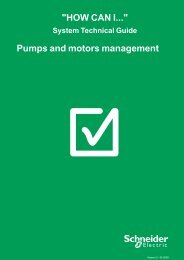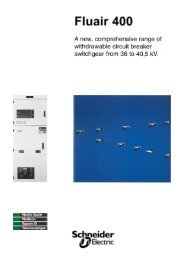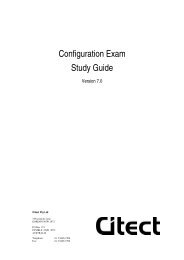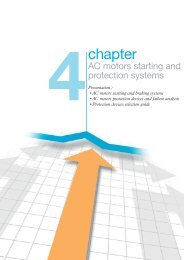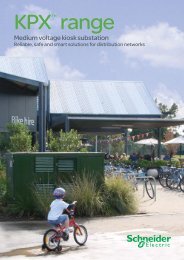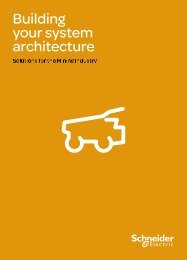Connect - Schneider Electric
Connect - Schneider Electric
Connect - Schneider Electric
Create successful ePaper yourself
Turn your PDF publications into a flip-book with our unique Google optimized e-Paper software.
2 SUSTAINABLE DEVELOPMENT<br />
SCHNEIDER ELECTRIC’S COMMITMENT TO ENVIRONMENTAL PERFORMANCE<br />
68<br />
In the future, sites with the highest water consumption and the most<br />
exposed sites will be the focus of particular attention and of specifi c<br />
action plans, after the implementation of pilot sites in the major<br />
world regions (America, Europe & Africa, Asia & Pacifi c).<br />
Energy consumption<br />
See the Group’s energy consumption action plans pages 62-64 .<br />
Raw material consumption<br />
<strong>Schneider</strong> <strong>Electric</strong> focuses on making its devices more compact<br />
to conserve natural resources so that customers have more<br />
environmentally friendly products to choose from. The Group<br />
has developed design tools for managing thermal and electrical<br />
constraints so that it can optimise the amount of materials required<br />
in production. Each device’s Product Environmental Profi le<br />
(PEP) lists the materials used. To facilitate end-of-life processing,<br />
<strong>Schneider</strong> <strong>Electric</strong> chooses materials that are easy to recycle and<br />
clip-together components that are easy to disassemble. Life cycle<br />
analyses and recyclability assessments also help the Group identify<br />
areas for improvement.<br />
For more information on the <strong>Schneider</strong> <strong>Electric</strong> global action plan<br />
relating to PEP and to end-of-life instructions, see the Green<br />
Premium chapter on page 64 . Also see the Green Plastic program<br />
on page 64 .<br />
<strong>Schneider</strong> <strong>Electric</strong>’s desire to reduce its environmental impact<br />
has driven its focus towards the use of recycled raw materials.<br />
For example, 85% of cardboard used in Europe and 100% in Asia<br />
comes from recycled material. North America is less advanced with<br />
about 50%. With regard to metals that <strong>Schneider</strong> <strong>Electric</strong> purchases<br />
on global markets, these include recycled material from recovered<br />
waste. The UNEP (United Nations Environment Program) report<br />
was published in 2011 addressing the situation with regard to metal<br />
recycling rate. On a global level, 18 metals have a recycling rate of<br />
over 50%, among which are lead, gold, silver, aluminium, tin, nickel,<br />
zinc, copper and iron and 34 elements have a recovery rate below<br />
1%, including rare earth elements. The UNEP recommends that<br />
priority be given to product design in order to facilitate disassembly<br />
and recovery of metals at end of life and to emphasise recycling<br />
electrical and electronic equipment (WEEE). <strong>Schneider</strong> <strong>Electric</strong><br />
participates in the recycling systems via the recovery of its own<br />
waste, with a target of 85%, and the End-of-Life Instructions for<br />
its products.<br />
Management of waste, emissions and industrial<br />
pollution<br />
Waste<br />
Because waste is a major source of pollution but also a potential<br />
source of raw materials, waste management is a priority in<br />
environmental protection.<br />
Most of the Group’s waste is solid waste. Continuous improvement<br />
plans have been deployed to manage this waste. This approach<br />
fi ts in fully with the ISO 14001 approach that all <strong>Schneider</strong> <strong>Electric</strong><br />
production and logistics sites worldwide are required to follow.<br />
The target of the One program 2009-2011 was to recover 85% of<br />
hazardous and non-hazardous waste.<br />
REGISTRATION DOCUMENT 2011 SCHNEIDER ELECTRIC<br />
Because classifi cation systems vary widely from country to country,<br />
the Group does not consolidate global data by category (hazardous<br />
and non-hazardous). Data is processed to ensure local traceability.<br />
In France, for example, hazardous industrial waste accounts for<br />
around 14% of total waste. All waste is channelled to the appropriate<br />
treatment facility.<br />
<strong>Schneider</strong> <strong>Electric</strong> notes the quantities of waste produced and<br />
recycled on a six monthly basis and monitors this production per<br />
capita, on a like-for-like basis in order to evaluate its performance<br />
from one year to the next.<br />
The overall eco-production approach helped reduce our production<br />
of waste by 7.1% per capita in 2011 compared with 2010 on a<br />
comparable basis and to increase the proportion of waste recycled<br />
from 82% at the end of 2010 to 84% at the end of 2011 on a<br />
comparable basis.<br />
Conditions of use and contamination of soils<br />
Virtually all <strong>Schneider</strong> <strong>Electric</strong> sites are located in urban or industrial<br />
areas and do not affect any notable biotopes. None of the Group’s<br />
businesses involve extraction or land farming.<br />
No substances are purposely released into the soil in the course of<br />
site operation. Workshop fl ooring at risk is given a waterproof seal<br />
using a suitable treatment (resin retention). Hazardous substances<br />
are systematically stored and handled in areas equipped with<br />
retention tanks in compliance with regulations. As a result of<br />
developments in legislation, retention systems are being designed<br />
more and more to compensate in the event of malfunctions or<br />
emergencies, such as fi res.<br />
In 2011 <strong>Schneider</strong> <strong>Electric</strong> conducted its annual review of pollution<br />
risks at all manufacturing sites as part of ISO 14001 tracking. No<br />
major incidents were reported in 2011.<br />
Discharge into the water and air<br />
Because <strong>Schneider</strong> <strong>Electric</strong> is mainly an assembler, its discharge<br />
into the air and water is very limited. Mechanical component<br />
production workshops are carefully monitored, in keeping with<br />
their ISO 14001 certifi cation. Their releases are tracked locally as<br />
required by current legislation. No major spills or discharges were<br />
reported in 2011.<br />
Emissions of NOx and SOx and particles into the air are monitored<br />
site by site according to their heating activity; monitoring of these<br />
emissions is verifi ed via ISO 14001 audits. Emissions are then<br />
monitored by the site managers with respect to the thresholds<br />
defi ned in local legislation and monitored by the heads of the<br />
geographical areas (see SERE organisation page 61 ). These<br />
emissions are not subject to consolidation at Group level.<br />
The COV emissions have been identifi ed as representative of Group<br />
levels and are therefore included in Group reporting.<br />
Finally, the CFC and HCFC emissions are monitored through our air<br />
conditioners in accordance with legislation. They are not linked to<br />
our industrial activities.




